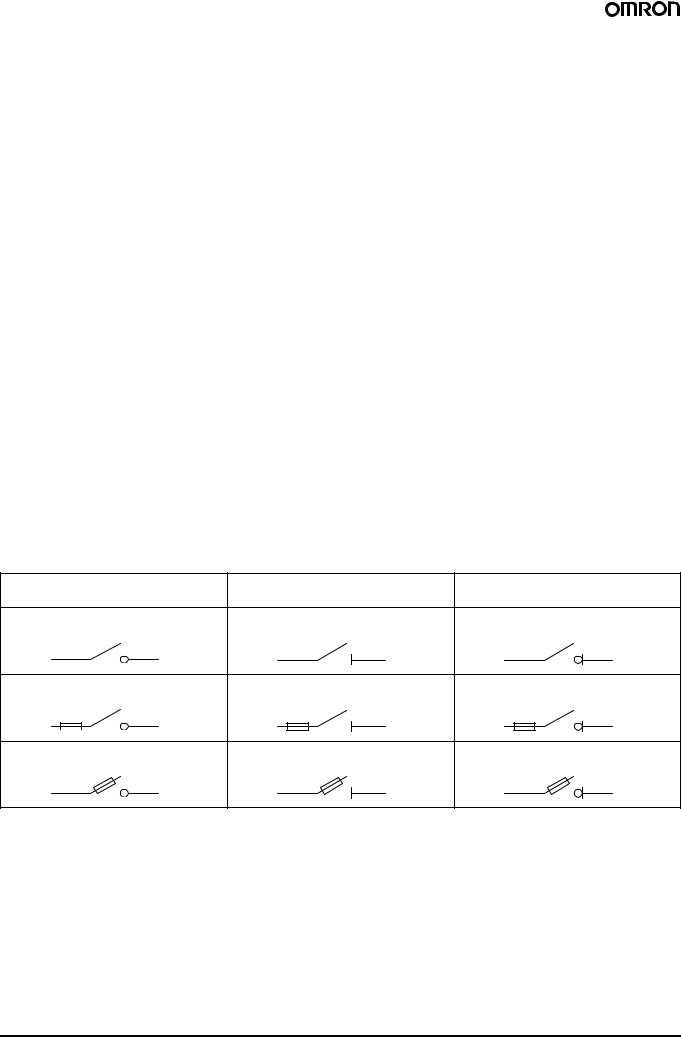Omron EN 60947, IEC 947 DATASHEET

Low Voltage Switch Gear
Appendix
Precautions
■ Notice
Use under rated condition, otherwise contactors will not only cause malfunction, but also cause a fire or damage the contactor.
Life period of contactor depends on the operating application. Please check the electrical life under real application in advance.
If you continue to use malfunctioning contactor, a fire or breakdown may occur.
Do not miss-wire or miss-charge the power supply, otherwise the contactor does not work correctly.
Do not use a contactor or thermal relay which has been dropped or dismantled. Doing so may cause malfunction or a fire.
Make sure to shut off power supply to contactors before wiring or replacing.
Do not operate the actuator of a contactor manually. Doing so may cause contact welding by chattering or burn out by arc.
Do not operate in places with explosive or flammable gas, otherwise a fire or explosion may occur by arc or heating from contactor.
Make sure to use the circuit well considered about safety, in case there is any possibility to cause secondary disaster by contact trouble (welding, faulty contact).
Do not supply short-circuit current to electromagnetic switch (contactor with thermal relay). Doing so may result failure in heater of thermal relay. Please use short-circuit protection like fuse or protective circuit breaker.
Unless otherwise stated in the catalogue, modifications, especially those of stated values, sizes and weights are subject to alternation.
Diagrams and tables are subject to alternation and not to be regarded as binding drawings.
■ Correct use
General use
Unexpected malfunction may occur in real application. Please carry out as many tests as possible.
Ratings in this catalogue measured under the condition according to IEC unless otherwise specified. In cases of check by real application, please carry out the test under the same condition as expected in the actual application.
Selection
Coil specification
Please select suitable coil to circuit design, otherwise malfunction may occur or coil may have a burn out by overvoltage etc.
Type
Please check contact ratings, switching capacity, thermal characteristics etc. when selecting product type.
Thermal relay
Motor current differs by supplier, type, number of poles, frequency. Please confirm operational current level.
Coil surge suppressor
Coil surge suppressor type should be selected by contactor type, auxiliary relay type and applied voltage. Make sure to use defined each contactor.
In case of installing coil surge suppressor, please check the actual circuit because the release time will be delayed.
Electrical life expectancy
Electrical life expectancy tests in this catalogue are based on IEC.
Circuit design
Supplied voltage waveform for input
Make sure to apply and remove the voltage instantly. Do not use under the condition that the coil voltage waveform increases or decreases gradually.
In case of DC contactor use (input voltage ripple)
Please use DC contactor input voltage with a ripple ratio less than 5%. Excessive ripple (pulsating current) may cause contact welding.
Fluctuation of input voltage
Make sure to supply sufficient voltage to actuate contactors properly. Continuous supply of insufficient voltage results in excessive heating and may cause burn out of coil.
Maximum applied voltage
Do not supply the voltage over the maximum rated voltage, otherwise burn out or insulation failure may occur.
The temperature inside control panel has much influence to the coil temperature, so make sure not to exceed the specified value in the catalogue.
Basically rated voltage should be supplied to coil. To supply higher voltage than rated would result in shorter electrical life, even if it is lower than the maximum rated voltage.
Reverse
Make sure to use reversible contactors for reverse operation.
Make sure to use interlock device in reverse operation by two contactors, otherwise short circuit current may burn out or give damage to contactors and motors.
Low Voltage Switch Gear Appendix |
81 |

Installation
Mounting
Make sure to use specified wire size, mounting screw size, mounting screw number, and DIN rail size.
Tightening Screw
Tighten each screw securely by specified tightening torque. Loose tightening may cause a fire by excessive heating.
Combination
Please use only OMRON product combinations in case of thermal relay, timer block and auxiliary contact block etc.
Wrong-combinations may result in damage to contactors.
Mounting direction
Some products have a defined specific mounting direction. Please refer to datasheet before use.
Operation ambience
Dust
Dust on the surface of the contacts could result in contact malfunctioning. Take countermeasure in excessive dusty surrounding.
Temperature, humidity
Use contactors within the temperature and humidity conditions specified in datasheet. To use or store contactor in excessive temperature or humidity may result in malfunction of contact by organic film composed by sulfication and oxidation on the surface of the contacts.
Use contactors within the temperature and humidity conditions specified in the datasheet, to prevent contactors from insulation resistance failure by condensation or insulation resistance deterioration by tracking.
Gas
NH3, H2S, SO2, CI2, Si and NO2 have bad effects on a contactor. With these gases, a corrosive metal film ist generated on the surface of the contacts and could result in contact malfunctioning. Use a contactor in low humidity and no corrosive gas surroundings.
Oil
Do not use a contactor in places where oil is sprayed onto the contactor. It will cause cracks on polymer parts.
Shock and vibration
Do not use a contactor in places where there is excessive shock or vibration. It may cause malfunctioning.
Storage
Store contactors in a place with no direct sunshine or ultraviolet rays. It will cause crack on polymer parts.
When contactors are to be stored for a long time, they must be stored with care. Though it generally depends where contactors are stored, deterioration of contacts may occur after long storage. Please check the characteristics before use after long time storage.
82 |
Low Voltage Switch Gear Appendix |

European Standards
■IEC 947, EN 60947
European Standards for Low-Voltage Switchgear
For Europe and most other industrial countries of the world, the new IEC 947 and EN 60 947 specifications for low-voltage switchgear have unified the regulations which previously varied from nation to nation.
This required the introduction of new terms, and new test methods and utilization categories. The new specifications are aimed primarily at manufacturers. However, the user also will come across new technical terms and data in the manufacturers’ catalogues
and on the devices themselves which are important for the selection and application of the devices. The present paper deals with the currently published specifications. Further specifications and supplements are in preparation.
Since 1993, all low-voltage switchgear purchased in Europe had to satisfy the EN 60 947 European Standard. Installations in existence prior to 1993 are not affected by the standard and need not to be refitted with new devices. Devices constructed and tested to the IEC standards and EN standards can be used worldwide, with the exception of the USA and Canada. In these countries UL and CSA specifications continue to apply. Switchgear which conforms to IEC 947 and EN 60 947 and which has, in addition, ULand CSA approvals, in the meantime has entered the market. Such ‘world market’ devices offer the advantage that they can be used throughout the world, including the USA and Canada.
IEC 947
IEC 947-1 |
General rules |
|
IEC 947-2 |
Circuit-breakers |
|
IEC 947-3 |
Switches, disconnectors, switch-disconnectors and fuse-combination units |
|
|
|
|
IEC 947-4-1 |
Connectors and motor-starters |
|
IEC 947-5-1 |
Control circuit devices and switching elements |
|
IEC 947-6-1 |
Multiple function equipment, Automatic transfer switching equipment |
|
IEC 947-6-2 |
Multiple function equipment, Control and protective switching devices (or equipment) |
|
|
(CPS) |
|
IEC 947-7-1 |
Ancillary equipment |
|
Conditions for compliance with Type "1" coordination
(Extract from IEC 947-4-1)
-The contactor or the starter must not endanger personnel or equipment in the event of a short circuit
-The contactor or the starter does not need to be suitable for continued operation without repair and replacement of parts
-Damage to the contactor and the overload relay is permissible
Conditions for compliance with Type "2" coordination
(Extract from IEC 947-4-1)
-The contactor or the starter must not endanger personnel or equipment in the event of a short circuit
-The contactor or the starter must be suitable for further use
-No damage may occur to the overload relay or other parts, with the exception of welding of the contactor or starter contacts, provided they can be separated easily without any significant deformation (e.g. using a screwdriver)
Rated conditional short-circuit current lq
-The rated conditional short-circuit current lq indicates the max. shortcircuit breaking capacity of the starter
Rated operation current le
-The rated operational current le for the starter is the current when the starter is in the On position
Rated uninterrupted current lu
(to IEC 947-1)
-The rated uninterrupted current lu of a unit is a current, specified by the manufacturer, which the unit can carry without interruption
Low Voltage Switch Gear Appendix |
83 |

Overview
The following table shows in summarized form both the previous and the new IEC, EN and DIN VDE standards.
Previous specification |
New specification |
|
|
|
|
|
|
|
|
|
|
|
EN 60947 |
|
IEC |
DIN VDE |
IEC |
DIN VDE |
Content |
|
|
|
|
|
- |
- |
947-1 |
60947-1 |
Low-voltage switchgear, |
|
|
|
0660, Part 100 |
General rules |
|
|
|
|
|
157 |
0660, Part 101 |
947-2 |
60947-2 |
Low-voltage switchgear, |
|
|
|
0660, Part 101 |
Circuit-breakers |
|
|
|
|
|
406 |
0660, Part 107 |
947-3 |
60947-3 |
Low-voltage switchgear, |
|
|
|
0660, Part 107 |
Switches, |
|
|
|
|
Disconnectors, |
|
|
|
|
Switch-disconnectors, |
|
|
|
|
Fuse-combination units |
|
|
|
|
|
158 |
0660, Part 102 |
947-4-1 |
60947-4-1 |
Low-voltage switchgear, |
292-1 |
0660, Part 104 |
|
0660, Part 102 |
Control circuit devices and switching elements |
292-2 |
0660, Part 106 |
|
|
|
292-3 |
0660, Part 301 |
|
|
|
|
|
|
|
|
337 |
0660 Part 200 to Part 205 |
947-5-1 |
60947-5-1 |
Low-voltage switchgear, |
|
|
|
0660, Part 200 |
Multiple-function equipment, |
|
|
|
|
Automatic transfer switching equipment |
|
|
|
|
|
- |
- |
947-6-1 |
60947-6-1 |
Low-voltage switchgear, |
|
|
|
0660, Part 114 |
Multiple-function equipment, |
|
|
|
|
Control and protective switching devices (CPS) |
|
|
|
|
|
- |
0611 Part 1 and 2 |
947-7-1 |
60947-7-1 |
Low-voltage switchgear, |
|
|
|
0611, Part 1 |
Ancillary equipment (e.g. terminal blocks) |
|
|
|
|
|
Switches, disconnectors, switch-disconnectors and fuse combination units (IEC 947-3, EN 60947-3)
These devices must now be labelled with the product function designated by the manufacturer. This means placing clearly visible symbols on the device itself.
Devices with an isolating function are subject to special safety requirements. They must for example have greater creepage distances and clearances across the opened contacts than is necessary for other devices.
Device functions and corresponding symbols
|
|
Making/breaking |
Making/breaking |
Isolating |
+ isolating |
Switch |
Disconnector |
Switch-disconnector |
Switch-fuse |
Disconnector-fuse |
Switch-disconnector-fuse |
Fuse-switch |
Fuse-disconnector |
Fuse switch-disconnector |
OMRON equipment is designed for the world’s markets
It is manufactured and tested in accordance with national and international specifications, the most important of which are listed below:
IEC 947-..., EN 60947: |
Low-voltage switch gear and control gear |
IEC 664: |
Insulation co-ordination including clearances and creepage distances for equipment |
IEC364: |
Electrical installations of buildings |
IEC 204-..., EN 60204-...: |
Electrical equipment of industrial machines |
DIN VDE 0105: |
Operation of electrical power installations |
IEC 536: |
Protection against electric shock |
84 |
Low Voltage Switch Gear Appendix |

Utilization categories for contactors to IEC 947-4-1 and EN 60947
|
|
Typical examples of application |
Verification of electrical endurance |
|
|
|
Verification of rated making and breaking capacities |
|
|||||||||
|
|
I = current made, Ic = current broken |
|
|
|
|
|
|
|
|
|
|
|
|
|
|
|
Type of |
Utilization |
Ie = rated operational current |
Make |
|
|
|
Break |
|
|
Make |
|
|
|
Break |
|
|
|
|
|
|
|
|
|
|
|
|
|
|
|
|
|
||||
current |
category |
U = voltage before make |
Ie |
I |
U |
cos ϕ |
Ic |
Ur |
cos ϕ |
Ie |
I |
U |
cos ϕ |
Ic |
Ur |
cos ϕ |
|
|
|
Ue = rated operational voltage |
|
- |
- |
- |
- |
|
- |
- |
- |
- |
|||||
|
|
Ur = recovery voltage |
A |
Ie |
Ue |
|
Ie |
Ue |
|
A |
Ie |
Ue |
|
Ie |
Ue |
|
|
|
AC-1 |
Non-inductive or slightly inductive loads, resistance |
All values |
1 |
1 |
0.95 |
1 |
1 |
0.95 |
All values |
1.5 |
1.05 |
0.8 |
1.5 |
1.05 |
0.8 |
|
|
|
furnaces |
|
|
|
|
|
|
|
|
|
|
|
|
|
|
|
|
AC-2 |
Slip-ring motors: starting, switching off |
All values |
2.5 |
1 |
0.65 |
2.5 |
1 |
0.65 |
All values |
4 |
1.05 |
0.65 |
4 |
1.05 |
0.65 |
|
|
|
|
|
|
|
|
|
|
|
|
|
|
|
|
|
|
|
|
AC-3 |
Squirrel-cage motors: starting, switching off motors |
Ie ≤17 |
6 |
1 |
0.65 |
1 |
0.17 |
0.65 |
Ie ≤100 |
10 |
1.05 |
0.45 |
8 |
1.05 |
0.45 |
|
|
during running4 |
Ie > 17 |
6 |
1 |
0.35 |
1 |
0.17 |
0.35 |
Ie > 100 |
10 |
1.05 |
0.35 |
8 |
1.05 |
0.35 |
||
|
AC-4 |
Squirrel-cage motors: starting, plugging, inching |
Ie ≤17 |
6 |
1 |
0.65 |
6 |
1 |
0.65 |
Ie ≤100 |
12 |
1.05 |
0.45 |
10 |
1.05 |
0.45 |
|
|
Ie > 17 |
6 |
1 |
0.35 |
6 |
1 |
0.35 |
Ie > 100 |
12 |
1.05 |
0.35 |
10 |
1.05 |
0.35 |
|||
|
|
|
|||||||||||||||
|
AC-5A |
Switching of electric discharge lamp controls |
- |
- |
- |
- |
- |
- |
- |
- |
3.0 |
1.05 |
0.45 |
3.0 |
1.05 |
0.45 |
|
|
|
|
|
|
|
|
|
|
|
|
|
|
|
|
|
|
|
AC |
AC-5B |
Switching of incandescent lamps |
- |
- |
- |
- |
- |
- |
- |
- |
1.52 |
1.05 |
2) |
1.52 |
1.05 |
2) |
|
AC-6A3 |
Switching of transformers |
As given by the manufacturer |
|
|
|
- |
- |
- |
- |
- |
- |
- |
|||||
|
|
|
|
||||||||||||||
|
AC-6B3 |
Switching of capacitor banks |
As given by the manufacturer |
|
|
|
- |
- |
- |
- |
- |
- |
- |
||||
|
AC-7A |
Slightly inductive loads in household appliances and |
As given by the manufacturer |
|
|
|
- |
1.5 |
1.05 |
0.8 |
1.5 |
1.05 |
0.8 |
||||
|
|
similar applications |
|
|
|
|
|
|
|
|
|
|
|
|
|
|
|
|
AC-7B |
Motor-loads for household applications |
As given by the manufacturer |
|
|
|
- |
8.0 |
1.05 |
1) |
8.0 |
1.05 |
1) |
||||
|
AC-8A |
Hermetic refrigerant compressor motor control with |
|
|
|
|
|
|
|
|
|
|
1 |
|
|
1 |
|
|
manual resetting of overload releases5 |
As given by the manufacturer |
|
|
|
- |
6.0 |
1.05 |
) |
6.0 |
1.05 |
) |
|||||
|
|
Hermetic refrigerant compressor motor control with |
|
|
|
|
|
|
|
|
|
|
1 |
|
|
1 |
|
|
AC-8B |
automatic resetting of overload releases5 |
As given by the manufacturer |
|
|
|
- |
6.0 |
1.05 |
) |
6.0 |
1.05 |
) |
||||
|
|
|
|
|
|
|
|
|
|
|
|
|
|
|
|
|
|
|
|
|
Ie |
I |
U |
L/R |
Ic |
Ur |
L/R |
Ie |
I |
U |
L/R |
Ic |
Ur |
L/R |
|
|
|
|
|
- |
- |
|
- |
- |
|
|
- |
- |
|
- |
- |
|
|
|
|
|
A |
Ie |
Ue |
ms |
Ie |
Ue |
ms |
A |
Ie |
Ue |
ms |
Ie |
Ue |
ms |
|
|
DC-1 |
Non-inductive or slightly inductive loads, resistance |
All values |
1 |
1 |
1 |
1 |
1 |
1 |
All values |
1.5 |
1.05 |
1 |
1.5 |
1.05 |
1 |
|
|
|
furnaces |
|
|
|
|
|
|
|
|
|
|
|
|
|
|
|
|
DC-3 |
Shunt motors: starting, plugging, inching, dynamic |
All values |
2.5 |
1 |
2 |
2.5 |
1 |
2 |
All values |
4 |
1.05 |
2.5 |
4 |
1.05 |
2.5 |
|
|
braking |
||||||||||||||||
DC |
|
|
|
|
|
|
|
|
|
|
|
|
|
|
|
||
|
|
|
|
|
|
|
|
|
|
|
|
|
|
|
|
||
DC-5 |
Series motors: starting, plugging, inching, dynamic |
All values |
2.5 |
1 |
7.5 |
2.5 |
1 |
7.5 |
All values |
4 |
1.05 |
15 |
4 |
1.05 |
15 |
||
|
|||||||||||||||||
|
|
braking |
|
|
|
|
|
|
|
|
|
|
|
|
|
|
|
|
DC-6 |
Switching of incandescent lamps |
- |
- |
- |
- |
- |
- |
- |
- |
1.5 |
1.05 |
2 |
1.5 |
1.05 |
2 |
|
|
2) |
) |
2) |
) |
|||||||||||||
Note 1: cos ϕ = 0.45 for Ie ≤100 A; cos ϕ = 0.35 for Ie > 100 A.
2:The tests are to be carried out with an incandescent light load.
3:The test data are to be derived from the test values for AC-3 or AC-4 according to Table VIIb, EN 60947-4-1.
4:AC-3 category may be used for occasional inching (jogging) or plugging for limited time periods such as machine set-up; during such limited time periods the number of such operations should not exceed five per minute or more than ten in a ten minute period.
5:A hermetic refrigerant compressor motor is a combination consisting of a compressor and a motor, both of which are enclosed in the same housing, with no external shaft or shaft seals, the motor operating in the refrigerant.
Utilization categories for control switches to IEC 947-5-1 and EN 60947
|
|
Typical examples of application |
Normal conditions of use |
|
|
|
|
Abormal conditions of use |
|
|
|
|
||||
|
|
I = current made, Ic = current broken |
|
|
|
|
|
|
|
|
|
|
|
|
|
|
|
|
Ie = rated operational current |
Make |
|
|
Break |
|
|
Make |
|
|
Break |
|
|
||
|
|
|
|
|
|
|
|
|
|
|
|
|
|
|
|
|
Type of |
Utilization |
Ue = rated operational voltage |
|
|
|
|
|
|
|
|
|
|
|
|
|
|
U = recovery voltage |
|
|
|
|
|
|
|
|
|
|
|
|
|
|
||
current |
category |
r |
|
I |
U |
|
Ic |
Ur |
|
|
I |
U |
|
Ic |
Ur |
|
U = voltage before make |
|
cos ϕ |
cos ϕ |
|
cos ϕ |
cos ϕ |
||||||||||
|
|
t0.95 = time in ms to reach 95 % of the steady-state |
|
- |
- |
- |
- |
|
- |
- |
- |
- |
||||
|
|
|
Ie |
Ue |
|
Ie |
Ue |
|
|
Ie |
Ue |
|
Ie |
Ue |
|
|
|
|
current |
|
|
|
|
|
|
||||||||
|
|
P = Ue x Ie = rated power consumption in watts |
|
|
|
|
|
|
|
|
|
|
|
|
|
|
AC |
AC-12 |
Control of resistive and solid state loads as in opto- |
|
1 |
1 |
0.9 |
1 |
1 |
0.9 |
|
- |
- |
- |
- |
- |
- |
coupler input circuits |
|
|
||||||||||||||
|
|
|
|
|
|
|
|
|
|
|
|
|
|
|
|
|
|
|
|
|
|
|
|
|
|
|
|
|
|
|
|
|
|
|
AC-13 |
Control of solid state loads with transformer isolation |
|
2 |
1 |
0.65 |
1 |
1 |
0.65 |
|
10 |
1.1 |
0.65 |
1.1 |
1.1 |
0.65 |
|
|
|
|
|
|
|
|
|
|
|
|
|
|
|
|
|
|
AC-14 |
Control of small electromagnetic loads (≤72 VA) |
|
6 |
1 |
0.3 |
1 |
1 |
0.3 |
|
6 |
1.1 |
0.7 |
6 |
1.1 |
0.7 |
|
|
|
|
|
|
|
|
|
|
|
|
|
|
|
|
|
|
AC-15 |
Control of electromagnetic loads (> 72 VA) |
|
10 |
1 |
0.3 |
1 |
1 |
0.3 |
|
10 |
1.1 |
0.3 |
10 |
1.1 |
0.3 |
|
|
|
|
|
|
|
|
|
|
|
|
|
|
|
|
|
|
|
|
|
|
|
|
|
|
|
|
|
|
|
|
|
|
|
|
|
|
I |
U |
|
Ic |
Ur |
|
|
I |
U |
|
Ic |
Ur |
|
|
|
|
|
- |
- |
t0.95 |
- |
- |
t0.95 |
|
- |
- |
t0.95 |
- |
- |
t0.95 |
|
|
|
|
Ie |
Ue |
|
Ie |
Ue |
|
|
Ie |
Ue |
|
Ie |
Ue |
|
DC |
DC-12 |
Control of resistive and solid state loads as in opto- |
|
1 |
1 |
1 ms |
1 |
1 |
1 ms |
|
- |
- |
- |
- |
- |
- |
coupler input circuits |
|
|
||||||||||||||
|
|
|
|
|
|
|
|
|
|
|
|
|
|
|
|
|
|
|
|
|
|
|
|
|
|
|
|
|
|
|
|
|
|
|
DC-13 |
Control of electromagnets |
|
1 |
1 |
6xP1) |
1 |
1 |
6xP1) |
|
1.1 |
1.1 |
6xP1) |
1.1 |
1.1 |
6xP1) |
|
DC-14 |
Control of electromagnetic loads having economy |
|
10 |
1 |
15 ms |
1 |
1 |
15 ms |
|
10 |
1.1 |
15 ms |
10 |
1.1 |
15 ms |
|
resistors in circuits |
|
|
|||||||||||||
|
|
|
|
|
|
|
|
|
|
|
|
|
|
|
|
|
|
|
|
|
|
|
|
|
|
|
|
|
|
|
|
|
|
Note 1: The value “6 x P” results from an empirical relationship which is found to represent most DC magnetic loads to an upper limit of P = 50 W, viz 6 x P = 300 ms. Loads having power consumption greater than 50 W are assumed to consist of smaller loads in parallel. Therefore, 300 ms is to be an upper limit, irrespective of the power consumption value.
Utilization categories for switches, disconnectors, switch-disconnectors, and fuse combination units to IEC 947-3 and EN 60947
|
|
Typical applications |
Verification of electrical endurance |
|
|
|
Verification of switching capacity |
|
|
|
||||||
|
|
I = current made, Ic = current broken |
|
|
|
|
|
|
|
|
|
|
|
|
|
|
Type of |
Utilization |
Ie = rated operational current |
Make |
|
|
|
Break |
|
|
Make |
|
|
|
Break |
|
|
|
|
|
|
|
|
|
|
|
|
|
|
|
|
|||
current |
category |
U = voltage before make |
Ie |
I |
U |
cos ϕ |
Ic |
Ur |
cos ϕ |
Ie |
I |
U |
cos ϕ |
Ic |
Ur |
cos ϕ |
|
|
Ue = rated operational voltage |
|
- |
- |
- |
- |
|
- |
- |
- |
- |
||||
|
|
Ur = recovery voltage |
A |
Ie |
Ue |
|
Ie |
Ue |
|
A |
Ie |
Ue |
|
Ie |
Ue |
|
|
AC-20 |
Connecting and disconnecting under no-load condi- |
|
1 |
1 |
1 |
1 |
1 |
1 |
|
1 |
|
1 |
1 |
|
1 |
AC |
A(B)2 |
tions |
All values |
) |
) |
) |
) |
) |
) |
All values |
) |
1.05 |
) |
) |
1.05 |
) |
|
AC-21 |
Switching of resistive loads, including moderate |
All values |
1 |
1 |
0.95 |
1 |
1 |
0.95 |
All values |
1.5 |
1.05 |
0.95 |
1.5 |
1.05 |
0.95 |
|
A(B)2 |
overloads |
||||||||||||||
|
AC-22 |
Switching of mixed resistive and inductive loads, in- |
All values |
1 |
1 |
0.8 |
1 |
1 |
0.8 |
All values |
3 |
1.05 |
0.65 |
3 |
1.05 |
0.65 |
|
A(B)2 |
cluding moderate overloads |
||||||||||||||
Low Voltage Switch Gear Appendix |
85 |

Utilization categories for switches, disconnectors, switch-disconnectors, and fuse combination units to IEC 947-3 and EN 60947 |
|
|
|
|
|
|
|
|
||||||||||
|
|
|
|
|
|
|
|
|
|
|
|
|
|
|
|
|
|
|
|
|
Typical applications |
Verification of electrical endurance |
|
|
|
Verification of switching capacity |
|
|
|
|
|||||||
|
|
I = current made, Ic = current broken |
|
|
|
|
|
|
|
|
|
|
|
|
|
|
|
|
Type of |
Utilization |
Ie = rated operational current |
Make |
|
|
|
|
Break |
|
|
Make |
|
|
|
Break |
|
|
|
|
|
|
|
|
|
|
|
|
|
|
|
|
|
|
|
|||
current |
category |
U = voltage before make |
Ie |
I |
U |
cos ϕ |
Ic |
Ur |
cos ϕ |
Ie |
I |
U |
cos ϕ |
Ic |
Ur |
cos ϕ |
||
|
|
Ue = rated operational voltage |
|
- |
- |
|
- |
- |
|
- |
- |
- |
|
- |
||||
|
|
Ur = recovery voltage |
A |
Ie |
Ue |
|
Ie |
Ue |
|
A |
Ie |
Ue |
|
Ie |
Ue |
|
||
|
AC-23 |
Switching of motor loads or other highly inductive |
All values |
1 |
1 |
0.65 |
1 |
1 |
0.65 |
Ie ≤100 |
10 |
1.05 |
0.45 |
8 |
1.05 |
0.45 |
||
|
A(B)2 |
loads |
I > 100 |
10 |
1.05 |
0.35 |
8 |
1.05 |
0.35 |
|||||||||
|
|
|
|
|
|
|
|
|
|
|
e |
|
|
|
|
|
|
|
|
|
|
|
|
|
|
|
|
|
|
|
|
|
|
|
|
||
|
|
|
Ie |
I |
U |
L/R |
Ic |
Ur |
L/R |
Ie |
I |
U |
L/R |
Ic |
Ur |
L/R |
||
|
|
|
|
- |
- |
|
|
- |
- |
|
|
- |
- |
|
- |
|
- |
|
|
|
|
A |
Ie |
Ue |
ms |
Ie |
Ue |
ms |
A |
Ie |
Ue |
ms |
Ie |
Ue |
ms |
||
|
DC-20 |
Connecting and disconnecting under no-load condi- |
|
1 |
1 |
|
1 |
1 |
1 |
1 |
|
1 |
|
1 |
1 |
|
|
1 |
DC |
A(B)2 |
tions |
All values |
) |
|
) |
) |
) |
) |
) |
All values |
) |
1.05 |
) |
|
) |
1.05 |
) |
|
DC-21 |
Switching of resistive loads, including moderate |
All values |
1 |
1 |
1 |
1 |
1 |
1 |
All values |
1.5 |
1.05 |
1 |
1.5 |
1.05 |
1 |
||
|
A(B)2 |
overloads |
||||||||||||||||
|
DC-22 |
Switching of mixed resistive and inductive loads, in- |
All values |
1 |
1 |
2 |
1 |
1 |
2 |
All values |
4 |
1.05 |
2.5 |
4 |
1.05 |
2.5 |
||
|
A(B)2 |
cluding moderate overloads (e.g. shunt motors) |
||||||||||||||||
|
DC-23 |
Switching of highly inductive loads (e.g. series mo- |
All values |
1 |
1 |
7.5 |
1 |
1 |
7.5 |
All values |
4 |
1.05 |
15 |
4 |
1.05 |
15 |
||
|
A(B)2 |
tors) |
||||||||||||||||
Note 1: |
If the switching device has a making and/or breaking capacity, the figures for the current and the power factor (time constants) must be stated by the manufacturer. |
|
|
|||||||||||||||
2: |
A: frequent operation, B: infrequent operation. |
|
|
|
|
|
|
|
|
|
|
|
|
|
|
|
|
|
Protection against electrical shock, to IEC 536
IEC 536 covers the setting up of electrical apparatus, and its arrangement in electrical installations with rated voltages up to 1000 VAC and 1500 VDC, with regard to protection against direct contact where operating elements such as push-buttons and switches are located in the vicinity of live parts.
“Finger-proofing” relates only to the operating device, and only in the normal direction of operation. A clearance of at least 30 mm radius from the centre point of the device to any live parts, must be ensured.
The IP 20 degree of protection is superior to “finger-proofing” in that it embodies protection against contact with electrical apparatus in any direction. Devices which are “finger-proof” and of IP 00 degree of protection can be provided with further protection against contact in the form of shrouding, if so desired.
Damp heat, constant, to IEC 68 Part 2-3
In this test, the effects of a constant high level of humidity
(93 +2/-3%) and a constant temperature (40 ±2)°C over a prescribed duration, are observed.
Damp heat, cyclic, to IEC 68 Part 2 - 30, Test Db
This test is used to assess the suitability of electrical products for operation and storage at high relative humidity levels, in conjunction with cyclic temperature fluctuation. A test cycle consists of 12 hours at 40 ±2°C, with relative humidity of 93 ±3%, and 12 hours at
25 ±3°C, with the relative humidity of at least 95%.
Ambient temperature
Ambient temperature is the temperature of the room (e.g. factory bay or switchgear room), in which the open or enclosed device is installed, a prerequisite being that this temperature is not significantly influenced by the heat losses from the device.
86 |
Low Voltage Switch Gear Appendix |

Glossary of standard terms
This Glossary offers brief expIanations of some of the standard terms used in this catalogue. However, it must not be regarded as a substitute for the actual text of the standard, especially where the new terms used in IEC 947 are concerned.
Reference is therefore made aIongside each such term to the reIevant section of the standard, e.g. IEC 947-1 in addition, IEV numbers are given to enable you to find foreign language equivalents in the International EIectrotechnicaI Vocabulary
(IEG 50), if required.
Rated conditional short-circuit current Iq
(IEC 947-1; 2.5.29/IEV 441-17-20)
The prospective current which a switching device, e.g. a circuitbreaker, protected by a short-circuit protective device such as a motor-protective circuit-breaker, can carry for the duration of the protective device tripping time.
Mininum command time
Minimum duration for a trip-initiating factor (controI puIse, short circuit) to effect the corresponding reaction, e.g. the short-circuit duration necessary to initiate tripping.
Rated breaking capacity
(IEC 947-1; 4.3.5.3)
The r.m.s. value of current which a switching device is capable of breaking according to its utiIization category. The rated breaking capacity is stated by reference to the rated operational voltage and the rated operational current.
The equipment must be capable of breaking any value of current up to and incIuding its rated breaking capacity stated.
Rated actuating voltage Uc (rated control circuit voltage)
(IEC 947-1; 4.5.1)
The voltage which is applied to the actuating make contact in a control circuit. Due to the presence in the controI circuit of transformers or resistors, this voltage may differ from the rated control supply voltage.
Rated service short-circuit breaking capacity Ics
(IEC 947-2; 4.3.5.2.2)
The prospective short-circuit current which, depending on the rated operationaI voltage, a circuit-breaker is capable of breaking repeatedly (test cycle: O - CO - CO; previousIy P-2). After interrupting this current vaIue, the circuit-breaker must be capable, despite its own thermal level having increased, of continuing to carry and disconnect in the event of overIoading, the rated uninterrupted current.
Rating or rated power
(IEC 947-1; 4.3.2.3)
The rated operational power which an equipment is capable of switching at the associated rated operational voItage in accordance with the utilization category.
For example:
motor contactor utilization category AC-3: 37 kW at 400 V.
Rated operational voltage Ue
(IEC 947-1; 4.3.1.1)
The voItage to which the characteristics of an equipment are referred. The rated operational current must not in any case exceed the rated insulation voltage.
Rated operational current Ie
(IEC 947-1; 4.3.2.3)
The current which an equipment is capabIe of carrying taking into account the rated operational current, duration of operation, utilization category and ambient temperature.
Rated uninterrupted current Iu
(IEC 947-1; 4.3.2.4)
The vaIue of current which an equipment can carry in uninterrupted duty (i.e. for weeks, months or years).
Rated making capacity
(IEC 947-1; 4.3.5.2)
The vaIue of current which an equipment is capabIe of switching On in accordance with the utilization category and at the rated operational voltage.
Rated frequency
(IEC 847-1; 4,3.3)
The frequency for which an equipment is designed and to which the other characteristic vaIues are referred.
Rated ultimate short-circuit breaking capacity Icu
(IEC 947-2; 4.3.5.2.1)
The maximum prospective fault current which a circuit-breaker is capable of interrupting
(test cycIe: O - CO; previously P-1)
Rated insulation voltage Ui
(IEG 947-1; 4.3.1 .2)
The voltage to which insulation tests and creepage distances of an equipment are referred. The maximum operationaI voltage must not in any case exceed the rated insulation voltage.
Rated short-circuit breaking capacity Icn
(IEC 947-1; 4.3.6.3)
The maximum value of current which an equipment is capable of switching Off at rated operational voItage and rated frequency, and without sustaining damage. It is expressed as r.m.s. value.
Motor rating
(IEC 947-1; 4.3.2.3)
Power output of a motor at the associated operational voltage.
Rated control supply voltage Us
(IEC 947-1; 4.5.1)
The voltage applied to the input terminals of the control circuit of an equipment. Due to the presence of transformers or resistors in the control circuit, this may differ from the rated actuating (control circuit) voltage.
Rated impulse withstand voltage Uimp
(IEC 947-1; 4.3.1 .3)
Measures the stability of the internal clearances of an equipment against overvoltage peaks. The utilization of suitable switchgear can ensure that overvoltages are prevented from transferring from the mains to deenergized system sections within it.
Rated current In
(of a circuit-breaker) (IEC 947-2; 4.3.2.3)
For circuit-breakers, this current value is equal to the uninterrupted current and the conventional free air thermaI current.
Low Voltage Switch Gear Appendix |
87 |
